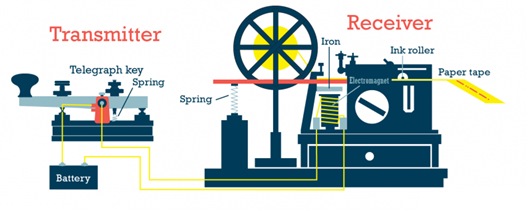Introduction
Communication is a fundamental part of being human. From ancient cave paintings to instant video calls today, humans have always sought ways to share ideas, feelings, and information. This basic desire to connect is the root reason why networks – and eventually the internet – were created. Understanding this history is crucial because it reveals the core problems that all communication systems, including modern computer networks, must solve. Every technological advancement was a response to the limitations of the previous era.
Why Humans Communicate
Below are the reasons for the inter communication between the human beings.
- Survival and Cooperation
- Early humans depended on each other for survival. Sharing information about food source, dangers, or weather conditions was essential for staying alive.
- Building Relationships
- Humans are social beings. Communication builds emotional bonds, trust, and communities.
- Exchange of Knowledge and Culture
- Communication allows knowledge, beliefs, traditions, and skills to pass from one generation to the next.
- Problem Solving and Innovation
- Complex tasks require collaboration, which is impossible without effective communication.
The Core Problem: Distance and the Limitation of the Human Voice
The primary problem that all communication technology seeks to solves is distance. The range of an unassisted human voice is severely limited. This constraint hindered collaboration, coordination, and the spread of information beyond immediate proximity.
Ancient Era solutions were physical and slow:
- Runners and Messengers:
- The earliest form of “
data transmission”. Information was carried physically from one place to another. The speed was limited to the speed of a human (or horse, or carrier pigeon), and the latency (the delay between sending and receiving a message) was extremely high – days, weeks, or even months for long distances. - Slow but reliable – used by ancient empires.
- The earliest form of “
- Visual Signals:
- Methods like smoke signals, beacon fires, and semaphore flags allowed messages to travel faster than a person could run, but they had significant drawbacks:
- Limited Bandwidth: They could only convey very simple, pre-arranged messages ("
danger", “victory”). The amount of information (bandwidth) was minuscule. - Line-of-Sight Required: They were useless in bad weather, over the horizon, or in obstructed terrain.
- No Privacy: The message was broadcast to anyone who could see it.
- Limited Bandwidth: They could only convey very simple, pre-arranged messages ("
- Methods like smoke signals, beacon fires, and semaphore flags allowed messages to travel faster than a person could run, but they had significant drawbacks:
Limitation:
These methods were slow, unreliable, and not scalable as populations grew and trade expanded.
The First Revolution: The Written Word and Physical Transport:
The invention of writing was a monumental leap. It allowed information to be captured, stored and transported with much greater fidelity than human memory.
- The Postal System: This was the world's first large-scale, standardized “
network” for information exchange. It establishes the concept of:- Addressing: A message needed a clear destination address to be routed correctly.
- Standardized Format: Letters followed a common format (envelope, stamp, address placement) – a primitive protocol.
- Intermittent Connectivity: Messages were not delivered in real-time but in batches.
However, the fundamental limitation remained: the message was still a physical object. Its transmission speed was still tied to the speed of its transportation (horse, ship, train).
The Electrical Revolution: Breaking the Speed of Light Barrier (19th Century):
The 19th century brought the most significant disruption in communication history since the invention of writing: the harnessing of electricity.
The Telegraph (1830s-1840s)
The telegraph was the true genesis of modern networking. It decoupled information from physical transport for the first time in human history. Messages could now travel at nearly the speed of light. It is first electrical communication system.
How it Worked: It used electrical pulses sent over a wire to control an electromagnetic sounder or paper tape writer on the other end.
Key Innovation: Encoding. Samuel Morse's brilliant insight was that you didn't need a separate wire for every letter. Instead, you could encode complex messages into a simple series of electrical pulses. Morse code (short pulses "dots" • and long pulses "dashes" –) was a binary protocol long before computers used binary.
Networking Concepts Introduced:
- Digital Encoding: Information was represented in a discrete, encoded format.
- The Medium: Copper wire acted as the physical medium for the signal.
- Protocol: Operators followed a strict set of rules for sending, receiving, and acknowledging messages.
- Addressing: Messages were addressed to specific recipients at a telegraph office.

The Telephone (1876):
While the telegraph was digital, the telephone, invented by Alexander Graham Bell, was analog. It aimed for a richer, more natural form of communication: the human voice.
How it Worked: It converted sound waves into analogous electrical waves that travelled over a wire and were reconverted into sound at the other end.
Key Innovation: Circuit Switching. To make a call, a dedicated electrical circuit had to be manually established (by an operator plugging cables into a switchboard) between the caller and the receiver. This circuit remained open and dedicated for the entire duration of the call.
Networking Concepts Introduced:
- Real-Time Communication: It enabled full-duplex, real-time conversation.
- Circuit Switching: The idea of a dedicated, end-to-end path for communication. This is efficient for constant traffic (like a voice call) but incredibly inefficient for bursty, intermittent data traffic (which defines modern computing).
- The "Last Mile" Problem: The challenge of connecting every individual home and business to the central network began here with the laying of millions of miles of copper wire.
The Birth of Computer Communication and The Problem of Sharing
Early “Computer” as a Singular Machine: Early computers like the ENIAC (1945) or UNIVAC (1951) were not personal devices. They were massive, room-sized machines that cost millions of dollars (in today's money) and were owned exclusively by large universities, government agencies, and corporations.
These monolithic computers were designed to run a single, specific job at a time. A programmer would physically prepare their program using punch cards or paper tape.
The “Sneakernet” Protocol: This is the crucial, often humorous, precursor to digital networking. If User A on the first floor finished their computation and User B on the third floor needed the output data to begin their work, the data transfer method was not electronic. It was physical. Someone (often a junior programmer or operator) would have to carry the stack of punch cards, the magnetic tape, or the printout from one machine to the other. This was wryly dubbed “Sneakernet” – using your sneakers to transfer data.
This model was incredibly inefficient. The computer itself, a priceless resource, would sit idle while it was being set up for the next job, while data was physically transported, and while operators loaded the next program.
The Need Arises
The pressure to make computing more efficient and powerful led to three revolutionary concepts that directly created the need for networking:
- Resource Sharing: Maximizing a Precious Asset
- Computers were astronomically expensive. Having one computer per user was unthinkable. The driving question became: “How can we let multiple people use the same computer at once?”
- Data Sharing: Beyond Physical Transportation
- The “sneakernet” model doesn't scale. Imagine a research team with 100 members needing access to the same dataset.
- The Problem: Physically copying and transporting tapes or card decks was slow, error-prone, and risked damage or loss. It also created multiple versions of the same file, leading to confusion.
- The Need: Researchers and businesses needed immediate, simultaneous access to the same data from different locations. They needed a “single source of truth”. This required a system where data could be stored in a central repository and accessed electronically by authorized users. This central repository would become the server.
- The “sneakernet” model doesn't scale. Imagine a research team with 100 members needing access to the same dataset.
- Collaboration: The Human Factor:
- This need extends from data sharing. Scientists working on a complex problem (e.g., physics simulations, weather modeling) needed to work together.
- The Problem: Without a connected system, collaboration meant mailing printouts or waiting for scheduled computer time, severely slowing down progress.
- The Need: They needed to be able to share results, run computations on shared data, and communicate about their work in real-time through the computer system itself. This required computers that could talk to each other.
The Answer: Connect the Computers
The problem of resource sharing, data sharing, and collaboration all pointed to the same solution.
Conclusion: The Stage is Set
This evolution from shouts to smoke signals, to letters, to the electrical telegraph and telephone, represents humanity's relentless drive to overcome the constraints of time and space. Each step introduced a core concept the would later become fundamental to computer networking: encoding, protocols, addressing, media, and switching.
Leave a comment
Your email address will not be published. Required fields are marked *


